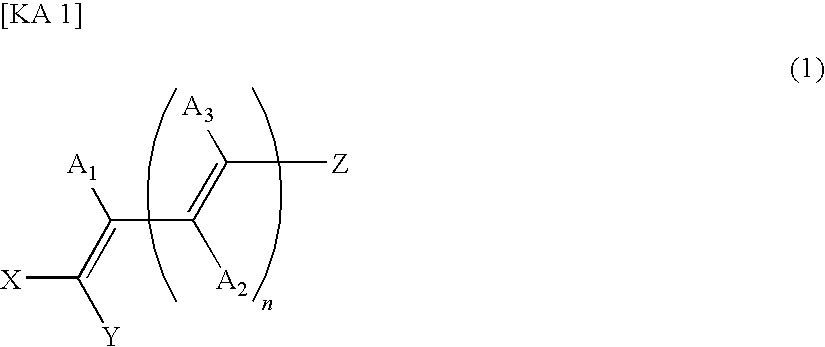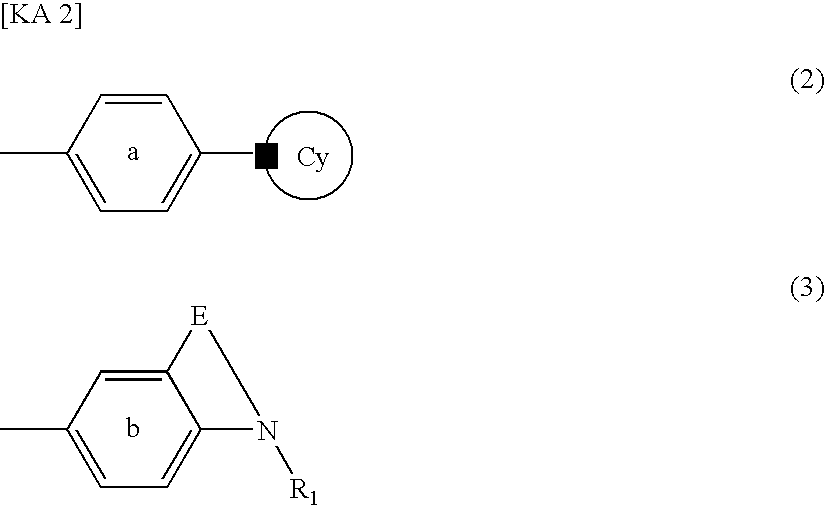Dye-sensitized photoelectric conversion device
a photoelectric conversion and dye sensitization technology, applied in the direction of methine/polymethine dyes, pv power plants, electrochemical generators, etc., can solve the problems of high cost of dyes themselves, difficult to use these batteries, and inability to supply, etc., to achieve high conversion efficiency and improve conversion efficiency
- Summary
- Abstract
- Description
- Claims
- Application Information
AI Technical Summary
Benefits of technology
Problems solved by technology
Method used
Image
Examples
example 1
[0149]Methyl cyanoacetate (1 part) and the following compound (318) (2 parts) were dissolved in ethanol (20 parts). Piperidine (0.01 parts) was added into this solution, then this solution was heated to reflux for 2 hours. After the reaction, the solution was cooled to deposit crystal, which was separated and purified by column chromatography followed by recrystallization with ethanol, to obtain orange crystal (2.1 parts). The orange crystal was refluxed in ethanol (20 parts) in the presence of potassium hydroxide (1 part) for 2 hours. Water (50 parts) was added into the reaction solution, then the reaction solution was neutralized with hydrochloric acid, and deposited orange crystal was filtered, washed with water, then recrystallized from ethanol, to obtain the compound of compound number (32a) (1.2 parts) as brownish orange crystal.
[0150]
[0151]Measured values of this compound for the maximum absorption wavelength and NMR were as follows.
[0152]Maximum absorption wavelength: λmax=4...
example 2
[0154]The same procedures were repeated as in Example 1 except that the above compound (318) (2 parts) was replaced with the following compound (319) (2 parts), to obtain the compound of compound number (278) (1.4 parts) as brownish orange crystal.
[0155]
[0156]Measured values of this compound for the maximum absorption wavelength and NMR were as follows.
[0157]Maximum absorption wavelength: λmax=395 nm (water:acetonitrile=7:3);
[0158]Measured values of NMR: 1H-NMR (PPM: d6-DMSO): 1.34 (t, 3H), 4.50 (m, 2H), 7.28 (m, 2H), 7.52 (m, 1H), 7.69 (t, 2H), 7.84 (m, 2H), 8.14 (d, 1H), 8.31 (d, 1H), 8.62 (d, 1H).
examples 3 to 9
[0159]The methine based dyes of the compound numbers shown in Table 7 were each dissolved in Ethanol (EtOH) so that concentration thereof became 3.2×10−4 M. A porous substrate (a semiconductor thin film electrode obtained by sintering porous titanium oxide at 450° C. for 30 minutes on a transparent conductive glass electrode) was dipped into the solution at room temperature (20° C.) for 12 hours to support each dye, then washed with a solvent (ethanol) and dried, to obtain a photoelectric conversion device of the present invention comprising a dye-sensitized semiconductor thin film. In Example 8 and Example 9, a photoelectric conversion device was similarly obtained by supporting 2 types of dyes by preparing an EtOH solution using 2 types of dyes (a methine based dye of the present invention and a compound of the following formula (320) which was a photo-sensitizing metal complex dye described in Non-Patent Literature 2 or a compound of the following formula (321) which was a photo-...
PUM
 Login to View More
Login to View More Abstract
Description
Claims
Application Information
 Login to View More
Login to View More - R&D
- Intellectual Property
- Life Sciences
- Materials
- Tech Scout
- Unparalleled Data Quality
- Higher Quality Content
- 60% Fewer Hallucinations
Browse by: Latest US Patents, China's latest patents, Technical Efficacy Thesaurus, Application Domain, Technology Topic, Popular Technical Reports.
© 2025 PatSnap. All rights reserved.Legal|Privacy policy|Modern Slavery Act Transparency Statement|Sitemap|About US| Contact US: help@patsnap.com



